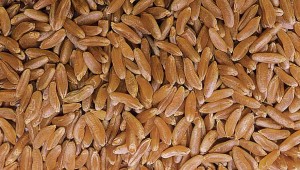The Whole Grain You Probably Haven’t Heard of But Should Totally Try
Lately, I’ve been bored with whole grains. Brown rice is great and all, but a girl can only eat so much. And, heck, even quinoa hasn’t been doing it for me these days. I’ve been in a straight-up whole-grain funk. So when the Kamut people emailed us asking if we’d like to try their brand of khorasan wheat, an ancient grain known for its health benefits, I was intrigued (and a little culinary spark went off in my belly).
Kamut Nutrition Facts
Before we get into a taste test, let’s talk Kamut nutrition and health benefits. First, this stuff is kind of a superfood. High in protein, fiber, selenium (an especially tough mineral to get naturally), zinc and magnesium, it pretty much kicks the crap out of its fellow plain whole-grain friend, wheat. And that nice mix of nutritionals makes it ideal for working out because it’s pretty high energy (read: carbs to get you moving and protein to help keep those muscles strong). Although you can’t buy it at most grocery stores as of now, your local health food store should stock it.
How the Heck You Eat Kamut Khorasan Wheat
I got to try Kamut khorasan wheat in a number of ways. Because it is a type of wheat, you can pretty much use it in the place of any recipe that calls for wheat. So my first Kamut culinary adventure was making Spent Grain Chocolate Chip Cookies (my hubs brews beer at home, leaving me with a surplus of spent grain, which—turns out—is delicious as dessert)! Everyone loves cookies, and I simply took whole-grain Kamut flour and subbed it for regular whole-wheat flour in the recipe. Because I can’t follow any recipe as is (my workout A.D.D. has crossed over to cooking A.D.D.) , I also added in some dried cherries and shredded coconut for fun. The result? Tastiness. The Kamut flour adds a subtle buttery flavor that tastes richer than your usual whole-wheat flour.
Next, I tried Kamut Vegetable Spirals pasta. Honestly, the stuff cooked just like normal pasta in the same amount of time and tasted like regular pasta. It was filling like whole-wheat pasta, but had a texture similar to white pasta, which was a nice change of pace from my usually chewy and dense wheat pasta. I ended my Kamut-tasting experience with just the organic Kamut grain itself. Not exactly a quick-cooking grain, I simmered some for about 90 minutes to eat as a side dish with some salmon and grilled veggies for dinner one night. With just a little salt and pepper, it was simple but good. More filling than brown rice in my opinion, it had a somewhat pleasantly sweet taste for a grain and—again—that subtle buttery flavor. While I don’t see myself making it regularly (it just takes too long), on a night where I have more time or am making a special meal, I’ll definitely bust it out again.
Now I just need to convince my husband to brew more beer so that I can make more Kamut cookies… —Jenn



Comments
I wonder if there are any slow-cooker recipes using it, since it takes so long to cook? If I find a good one I’ll post.
i found this one at: http://www.nutritionmd.org/recipes/view.html?recipe_id=339 & http://www.livestrong.com/article/478838-how-to-cook-kamut-in-a-crock-pot/ & http://www.livestrong.com/article/464718-how-to-cook-kamut-in-a-slow-cooker/
Comments are closed.